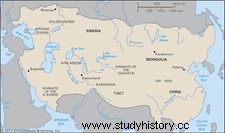Golden Horde , also Called Kipchak Khanate , Russian Label for the Ulus Juchi, the western part of the Mongolian Rich , which flourished from the mid-13th century to the late 14th century. The people of the Golden Horde were a mix of Turks and Mongols, with this one in the Rule forms the Aristocracy .
 Read more about this topic Mongol Empire:The Golden Horde The situation in Batus Ulus has long been one of antagonism to the Il Khan Empire. For more than a century...
Read more about this topic Mongol Empire:The Golden Horde The situation in Batus Ulus has long been one of antagonism to the Il Khan Empire. For more than a century... The ill-defined western part of the empire of Genghis Khan formed the territorial endowment of his eldest son Juchi . Juchi died in 1227 before his father but before his son Batu expanded its territory in a series of brilliant campaigns, including the sacking and burning of the city Kyiv in 1240. At its peak, the Golden Horde's territory stretched from the Carpathians in Eastern Europe into the steppes Siberia . To the south, the lands of the Horde bordered the Black Sea , the Caucasus and the Iranian areas of Mongol Dynasty, as Il-Khans are known .
Batu founded his capital Sarai Batu at the lower section of the Volga . The capital later became upriver to Sarai Berke relocated , which at its peak had perhaps 600,000 residents. The Horde gradually became Turkified and Islamized, particularly under their greatest khan, Öz Beg (1312-41). The Turkic tribes were centered on animal husbandry in the steppes, while their subjects, Eastern Slavs , Mordvinier , Greek, Georgian and Armenians , paid tribute. The Russian princes, especially those of Moscow , soon took on the responsibility of collecting the local tribute. The Horde engaged in extensive trade with Mediterranean peoples, particularly their allies in Mamlūk, Egypt and the Genoese.
The Black Death , which occurred in 1346/47, and the assassination of Öz Beg's successor marked the beginning of the decline and dissolution of the Goldene Horde. The Russian princes won a signal victory over the Horde General Mamai in the Battle of Kulikovo in 1380. Mamai's successor and rival, Tokhtamysh looted and burned Moscow in 1382 in retaliation and restored Horde rule over the Russians. However, Tokhtamysh had his own power through his former ally Timur broken, which invaded Horde territory in 1395, destroying Sarai Berke and most of the region's skilled artisans Central Asia deported , robbing the Horde of their technological advantage over the resurgent Muscovy.
In the 15th century the Horde split into several smaller khanates, the most important being that of the Crimea , Astrakhans and Kazans were. The last surviving remnant of the Golden Horde was destroyed by the Crimean Khan in 1502.
